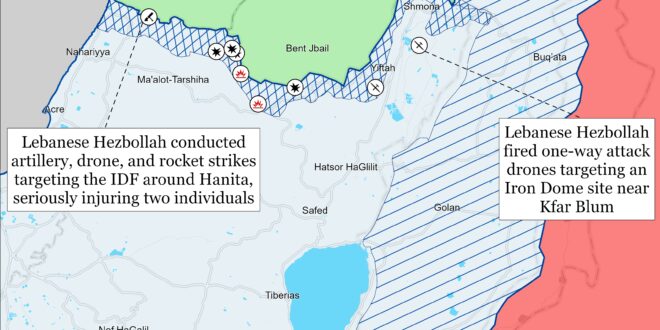The Islamic Revolutionary Guards Corps (IRGC) Aerospace Force launched a large-scale drone and missile attack from Iranian territory that targeted Israel from Iranian territory on April 13.[i] This marks the first time Iran has targeted Israel directly from Iranian territory.[ii] Israel Defense Forces (IDF) spokesperson Brig. Gen. Daniel Hagari confirmed that Iran launched drones and then missiles from Iranian territory towards Israel.[iii] The IRGC announced the start of operation “True Promise” at approximately 15:30 EST on April 13.[iv] The Iranian Supreme National Security Council approved the attack and the IRGC Aerospace Force conducted the attack under the supervision of the Armed Forces General Staff. The IRGC launched hundreds of drones towards Israel, including Shahed-136 one-way attack drones.[v] The attack included at least three attack waves over the course of several hours.[vi] Israeli media reported that the IRGC launched its operation from Kermanshah city, Kermanshah Province, and Dokuh, Hormozgan Province, in western Iran.[vii]
The United States, United Kingdom, Israel and Jordan began intercepting drones and missiles outside of Israeli airspace between 1700 and 1800 ET, according to Israeli media and several unspecified sources speaking to Israeli media.[viii] IDF spokesperson Hagari said in a press briefing that Iran launched over 200 drones, cruise missiles and ballistic missiles.[ix] Flight radar reported that the airspace over Iran, Israel, Jordan, Iraq and Lebanon is closed.[x] The Iranian Permanent Mission to the United Nations posted on X (Twitter) that the operation was launched in response to the April 1 Israeli airstrike targeting IRGC officials in Damascus. The Iranian Permanent Mission wrote that the Iranian ”True Promise” operation ”can be deemed concluded” at 1800 ET.[xi]
Members of Iran’s so-called “Axis of Resistance” appear to have conducted attacks targeting Israel simultaneously with Iran’s first wave of attacks. Lebanese Hezbollah claimed it fired ”dozens” of Katyusha rockets targeting an Israeli missile and artillery base in the Golan Heights at 1800 ET.[xii] The Houthis posted two promotional videos about destroying Israel during Iran’s wave of drone attacks, but has not claimed any attack at the time of writing.[xiii] The Iranian-backed Iraqi militia Faylaq al Waad al Sadiq (True Promise Corps) congratulated the Islamic Resistance in Iraq on April 13 for participating in the attack targeting Israel.[xiv] The Islamic Resistance in Iraq has not claimed an attack at the time of writing. The Iranian-backed Badr Organization posted a graphic celebrating Iran’s attack on Israel stating that “we are among the criminals taking revenge” suggesting that the militia may have supported the attack on Israel in an unspecified capacity.[xv]
The Israeli war cabinet convened on April 13 in Tel Aviv and remains in session.[xvi] Israel immediately took certain preventative measures after the first wave of drones were launched. Israel closed its airspace.[xvii] The Israel Defense Forces (IDF) evacuated several bases, deployed aircraft, and raised air defense readiness.[xviii] The IDF instructed residents along its northern border in the Golan Heights, Eilat, Dimona, and Nevatim (Negev region) to remain close to shelters.[xix]
Iran warned Israel’s partners, particularly the United States and Jordan, not to intervene in Iran’s attack against Israel. Supreme National Security Council-affiliated media warned the United States against intervening in Iran’s attack, claiming that Iran has prepared ballistic missile platforms to target “several US bases in the region.”[xx] The Iranian Permanent Mission to the UN similarly warned the United States to “stay away” from the conflict between Iran and Israel.[xxi] The United States and the United Kingdom have intercepted over 100 drones outside of Israeli airspace at the time of this writing.[xxii] IRGC-affiliated media separately warned Jordan that it will be Iran’s “next target” if it participates in an Israeli response to Iran’s attack.[xxiii] Iranian Defense Minister Brig. Gen. Mohammad Reza Ashtiani warned that Iran will give a “decisive response” to any country that allows Israel to use its airspace or territory to conduct a counterattack against Iran.[xxiv] Israeli media reported that Jordanian aircraft shot down Iranian drones headed toward Israel over northern and central Jordan.[xxv]
The composition of the ongoing Iranian attack on Israel is similar to the composition of Russian strikes have repeatedly targeted Ukraine. These Russian strikes have attempted to determine the optimal package to penetrate Western air and missile defenses. Russia has experimented with combinations of ballistic and cruise missiles alongside Iranian drones in Ukraine.[xxvi] Iran’s use of drones and missiles shows how Iran is learning from the Russians to develop increasingly dangerous and effective strike packages against Israel. Iran has also used the Houthi attacks in the Red Sea to refine Iranian drone tactics by testing US Navy air defenses.[xxvii] The ongoing Iranian attacks targeting provide Iran opportunities to evaluate the effectiveness of different strike packages to understand how they can evade and overwhelm US air and maritime defenses more effectively.
The Islamic Revolutionary Guards Corps (IRGC) Navy seized a Portuguese-flagged, Israeli-linked commercial vessel in the Strait of Hormuz on April 13, likely as part of its campaign to impose an unofficial blockade on Israel.[xxviii] IRGC-controlled media published a video of IRGC Navy forces repelling from a helicopter onto the MSC Aries.[xxix] The Zodiac Maritime, a shipping company owned by Israeli billionaire Eyal Ofer, owns the MSC Aries and chartered the vessel to the Mediterranean Shipping Company (MSC).[xxx] The MSC confirmed that the MSC Aries, which was en route from the United Arab Emirates (UAE) to India, was “boarded by Iranian authorities” and “diverted from her itinerary towards Iran.”[xxxi] IRGC-controlled media emphasized that the seizure of the MSC Aries “has nothing to do with Iran’s retaliatory measure” against Israel for the April 1 Israeli airstrike that killed seven IRGC officials in Damascus.[xxxii]
The IRGC Navy’s seizure of the MSC Aries comes amid increased Iranian threats to the UAE. IRGC Navy Commander Rear Adm. Ali Reza Tangsiri recently claimed that Israel’s presence in the UAE threatens Iran and reiterated the long-standing Iranian threat to close the Strait of Hormuz during an interview with Lebanese Hezbollah-controlled media on April 9.[xxxiii] Israel has increasingly relied on an overland trade route that connects Haifa to Dubai via Jordan and Saudi Arabia to compensate for reduced trade activity at the Port of Eilat due to the Houthis’ anti-shipping campaign.[xxxiv] Tehran and its regional allies have threatened to disrupt the Israeli ground connection to the Persian Gulf. Iranian state media and Iranian-backed Iraqi militias have criticized the UAE for allowing Israel to conduct trade through its territory.[xxxv] Iranian-backed Iraqi militias have specifically called for the dismantlement of Israel’s “land bridge” through Jordan.[xxxvi] The IRGC Navy may have specifically targeted the Aries MSC to increase pressure on the UAE to sever economic ties with Israel.
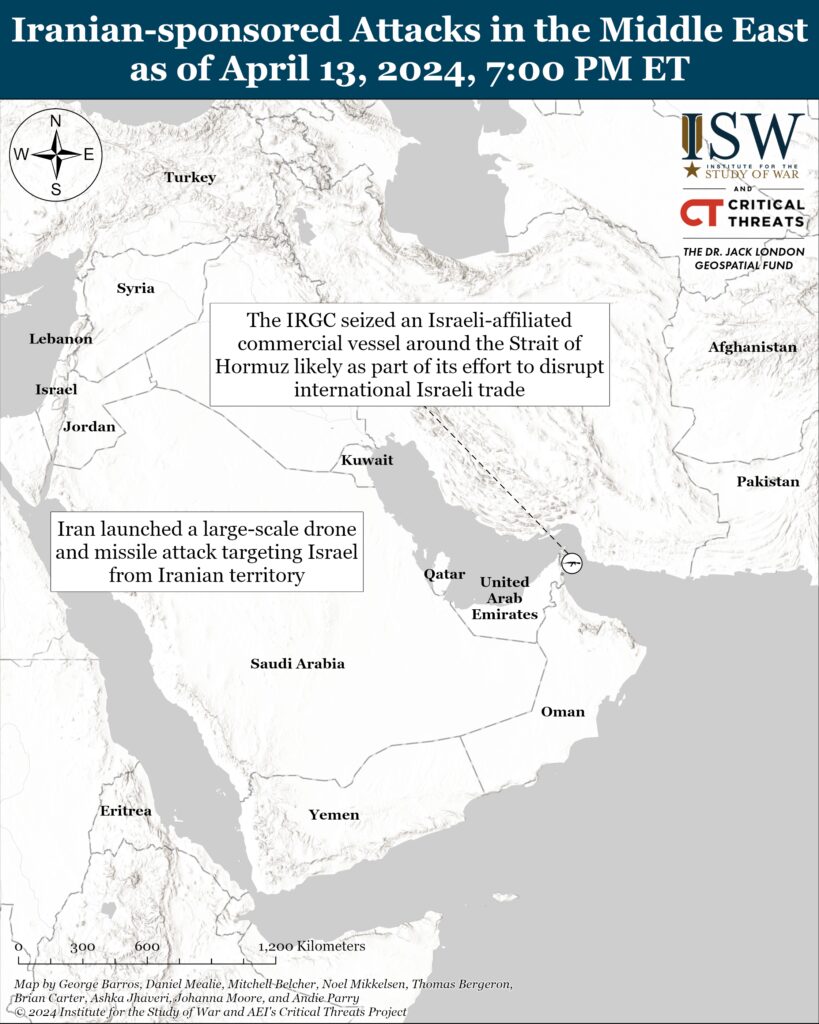
Key Takeaways:
- Iran: Iran launched a large-scale drone and missile attack from Iranian territory that targeted Israel from Iranian territory.
- The IRGC Navy seized a Portuguese-flagged, Israeli-linked commercial vessel in the Strait of Hormuz, likely as part of its campaign to impose an unofficial blockade on Israel
- Northern Gaza Strip: The IDF Air Force conducted an airstrike targeting Palestinian fighters in Beit Hanoun.
- West Bank: The IDF announced that it found the body of the missing 14-year-old Israeli boy in the West Bank near Malachi HaShalom. Israeli media is widely reporting that Israeli settlers committed acts of violence in at least eight Palestinian towns in the northern West Bank after the IDF found the missing boy’s body.
- Southern Lebanon and Golan Heights: Lebanese Hezbollah conducted at least 12 attacks from southern Lebanon into northern Israel.
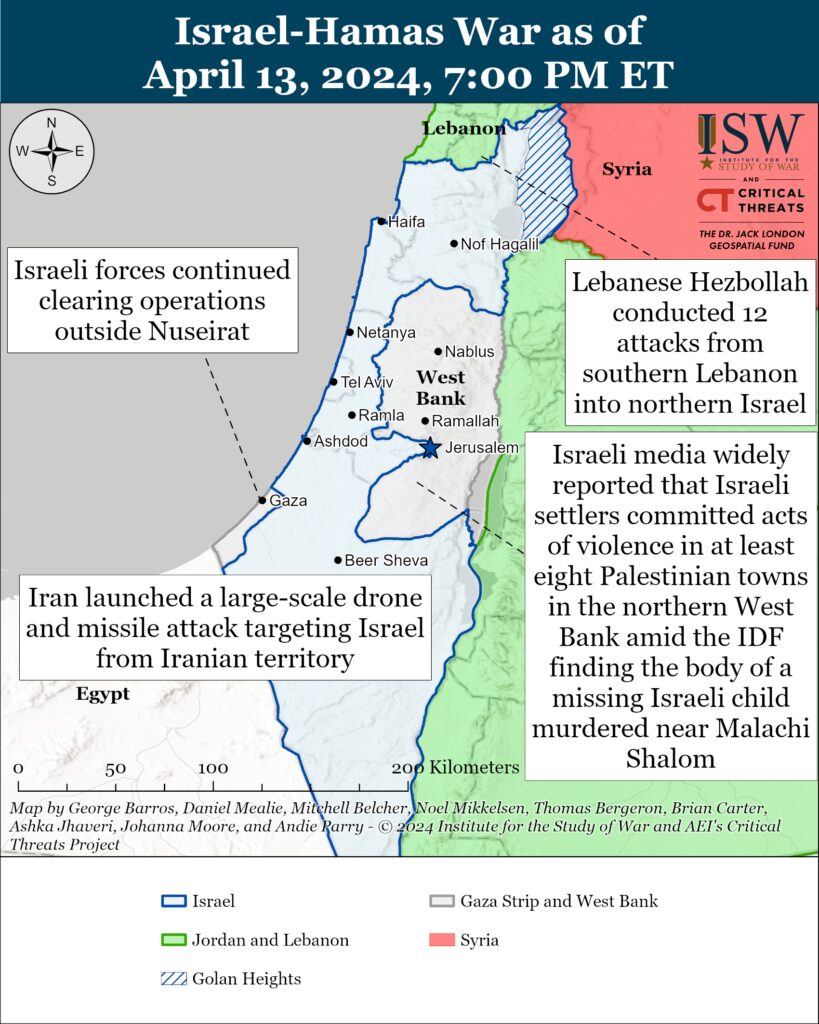
Gaza Strip
Axis of Resistance objectives:
Erode the will of the Israeli political establishment and public to sustain clearing operations in the Gaza Strip
Reestablish Hamas as the governing authority in the Gaza StripThe Israel Defense Forces (IDF) Air Force conducted an airstrike targeting Palestinian fighters in Beit Hanoun on April 13. The IDF Northern Brigade (Gaza Division) located the Palestinian fighters using a drone.[xxxvii] The IDF Northern Brigade most recently conducted a raid in Shujaiya neighborhood of Gaza City, south of Beit Hanoun.[xxxviii] CTP-ISW assessed on March 25 that a small number of Palestinian fighters have likely infiltrated Beit Hanoun.[xxxix] The IDF reported that Israeli forces killed a Hamas company commander for the Beit Hanoun area during clashes with Hamas fighters in the area on April 4.[xl] Palestinian militias continued ability to operate in the northern Gaza Strip is consistent with the assessed infiltration of fighters into the area and Hamas’ intentions to reassert its governing authority following Israeli withdrawals.
Israeli forces continued to conduct clearing operations outside Nuseirat along Wadi Gaza on April 13. Elements of the IDF 162nd Division, including the Nahal and 401st brigades, are operating in the area to kill Palestinian fighters and destroy military infrastructure.[xli] Israeli forces destroyed a Hamas weapons storage facility and confiscated military equipment belonging to the group during clearing operations.[xlii]Commercially available satellite imagery captured on April 12 shows flattened terrain in Zahra, north of Nuseirat, indicating that Israeli bulldozers and/or heavy vehicles are operating in the area.
Several Palestinian militias claimed attacks targeting Israeli forces near Nuseirat on April 13. The al Aqsa Martyrs’ Brigades, which is the self-proclaimed military wing of Fatah, reported that its fighters conducted five attacks north of Nuseirat during the past two days, which included firing a rocket-propelled grenade at an IDF tank.[xliii] The Popular Resistance Committees, which is a Palestinian militia aligned with Hamas in the war, and Palestinian Islamic Jihad (PIJ) fighters conducted separate mortar attacks targeting Israeli forces and a military position north of Nuseirat, respectively.[xliv]
The IDF Air Force struck over 30 targets in the Gaza Strip on April 13, including anti-tank equipment.[xlv]
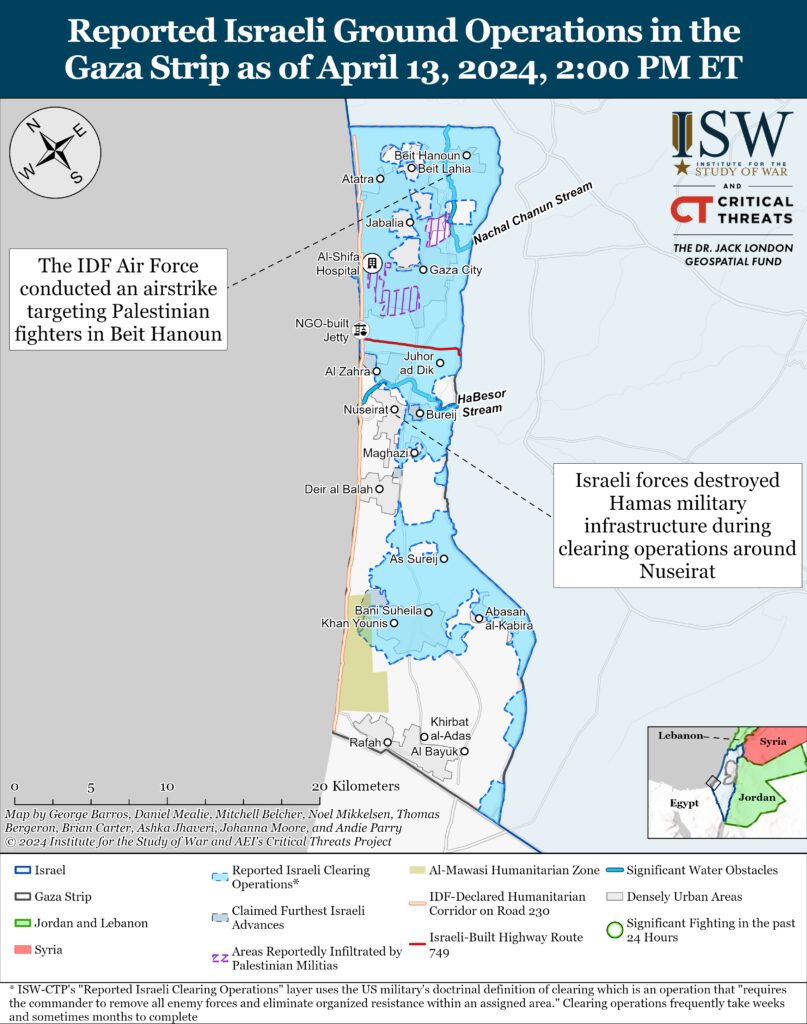
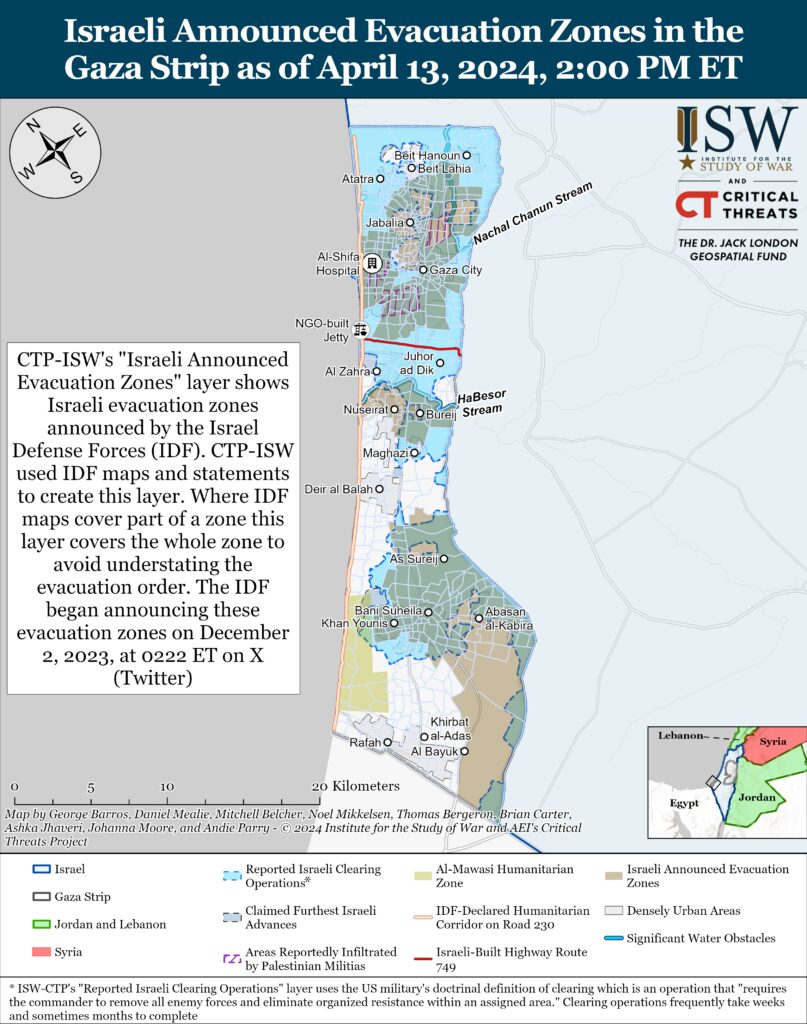
PIJ and the Democratic Front for the Liberation of Palestine (DFLP) conducted a combined rocket attack from the Gaza Strip targeting Sderot in southern Israel on April 12.[xlvi] The IDF said that it intercepted three rockets.[xlvii] Israeli artillery targeted the launch site of the attack in the Gaza Strip. The IDF Air Force struck three rocket launchers in the Gaza Strip that contained about 20 rockets ready to be launched into central Israel.
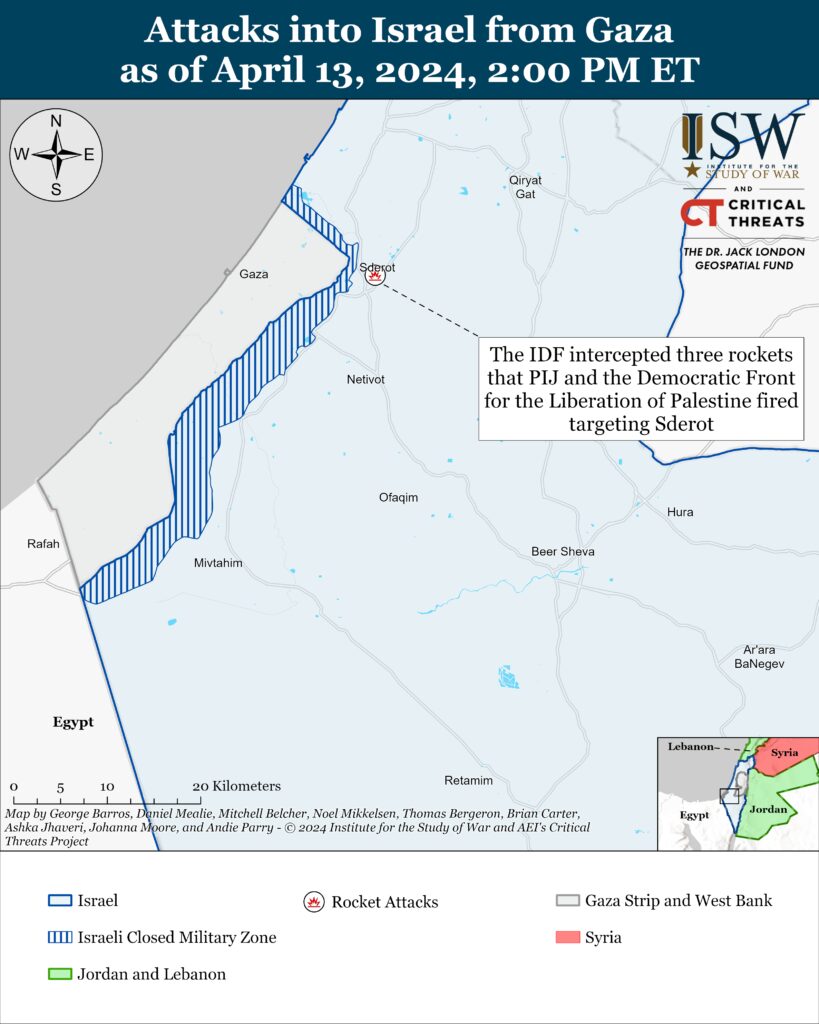
Recorded reports of attacks; CTP-ISW cannot independently verify impact.
West Bank
Axis of Resistance objectives:
Establish the West Bank as a viable front against IsraelThe IDF announced on April 13 that it found the body of the missing 14-year-old Israeli boy in the West Bank near Malachi HaShalom.[xlviii] The IDF reported that unspecified persons killed the boy with a blade and that the investigation is ongoing.[xlix] The IDF initially began searching for the boy with Israeli settlers on April 12 near the Israeli settlement of Malachi HaShalom.[l] Israeli and Palestinian media reported violence occurred in al Mughayir, a Palestinian town west of Malachi HaShalom, during the search on April 12. The IDF reported that there were “violent disturbances” in al Mughayir but that the Israeli forces entered the town and removed the Israeli settlers from the area.[li] Palestinian Authority-affiliated media confirmed that at least one Palestinian civilian died during the violence.[lii] Israeli Army Radio reported that the IDF is preparing for widespread riots and “disturbances” across the West Bank in response to the boy’s death[liii][liv]
Israeli media is widely reporting that Israeli settlers committed acts of violence on April 13 in at least eight Palestinian towns in the northern West Bank after the IDF found the missing boy’s body. The IDF reported that participants in clashes between Israelis and Palestinians in several areas of the West Bank threw stones and fired weapons.[lv] Israeli Army Radio reported that Israeli settlers rioted and committed acts of violence in al Mughayir, Dumas, Abu Falah, Beit Furik, and Kosra.[lvi] The Jerusalem Post cited unspecified Israeli, Arab, and US media who reported that Israeli settlers also targeted Deir Dibwan, Sinjil, and Beitin.[lvii] Israeli media and local reports reported that Israeli settlers set fire to cars and Palestinian homes.[lviii] There were also reports of casualties during the violence. The Palestinian Red Crescent reported that three Palestinians were wounded in al Mughayr.[lix]Israeli media reported that Israeli settlers fired small arms, killing a Palestinian in al Mughayir[lx] Israeli Army Radio reported that Israeli settlers shot and injured three Palestinians[lxi] [lxii][lxiii]
Senior Israeli cabinet officials appeared to call on Israeli settlers to return home in an attempt to restore order. Israeli Prime Minister Benjamin Netanyahu called on Israeli citizens to allow Israeli forces to operate “unhindered.”[lxiv] Israeli Minister of Defense Yoav Gallant added that “revenge” will make it difficult for Israeli forces to pursue the boy’s killers.[lxv] Gallant and Israeli War Cabinet Minister Benny Gantz urged the Israeli settlers not to take the law “into [their] own hands.”[lxvi] The IDF reported later on April 13 that clashes between Israeli settlers and Palestinians had ended.[lxvii]
Palestinian militias called for a general mobilization of fighters and Palestinian civilians in response to settler violence that occurred in the West Bank on April 12 and 13. Hamas called on Palestinian militias and civilians in the West Bank to take up arms and escalate “resistance activity” against Israeli forces and settlers.[lxviii] Hamas also called on the Palestinian Authority to exercise its authority to protect Palestinians in the West Bank.[lxix] The al Aqsa Martyrs’ Brigade announced a general mobilization of all of its fighters in Tulkarm to retaliate against the settler violence at al Mughayir.[lxx] The Popular Front for the Liberation of Palestine posted a statement calling for the formation of a “popular protection committee” in all Palestinian towns in the West Bank to “confront” settler “crimes” and to “thwart their malicious goals.”[lxxi]
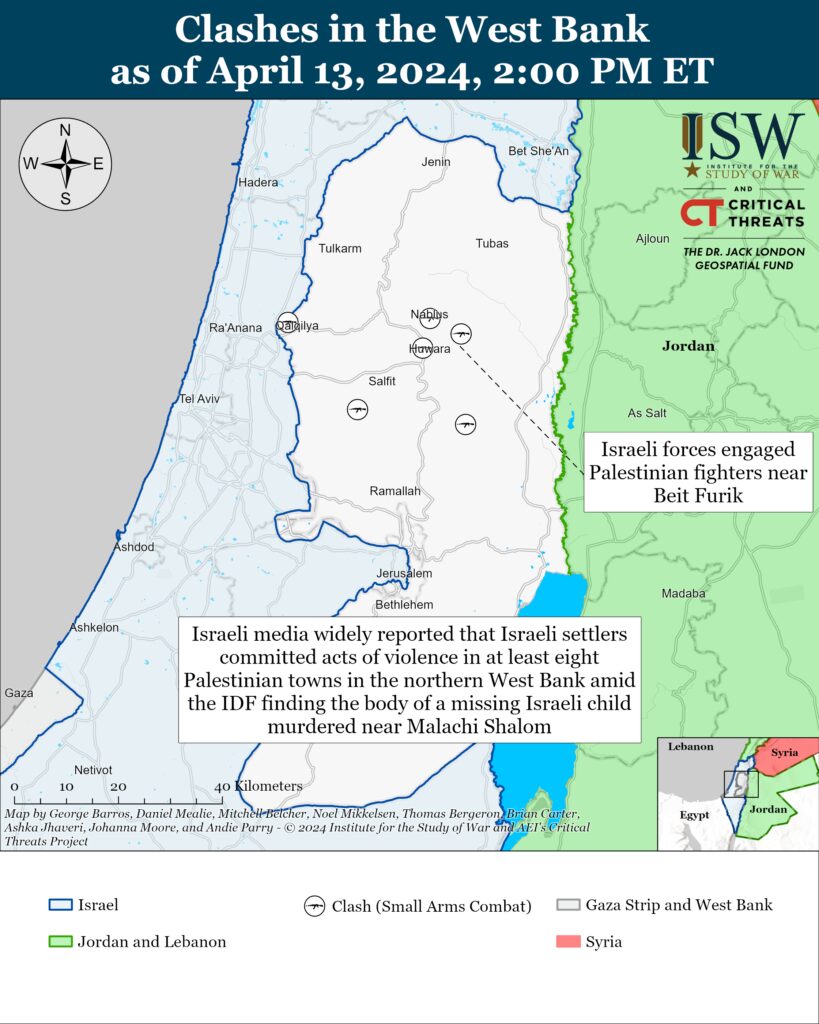
This map is not an exhaustive depiction of clashes and demonstrations in the West Bank.
Southern Lebanon and Golan Heights
Axis of Resistance objectives:
Deter Israel from conducting a ground operation into Lebanon
Prepare for an expanded and protracted conflict with Israel in the near term
Expel the United States from SyriaLebanese Hezbollah has conducted at least 12 attacks from southern Lebanon into northern Israel since CTP-ISW’s last data cutoff on April 11.[lxxii] Hezbollah fired one-way attack drones targeting an Iron Dome site near Kfar Blum.[lxxiii] The IDF confirmed that a drone fell in the Kfar Blum area.[lxxiv] Hezbollah claimed that the Israelis are using the site as an alternative to one at Kfar Blum after a Hezbollah attack targeting the Iron Dome batteries there in January 2024.[lxxv] CTP-ISW cannot corroborate the claim.
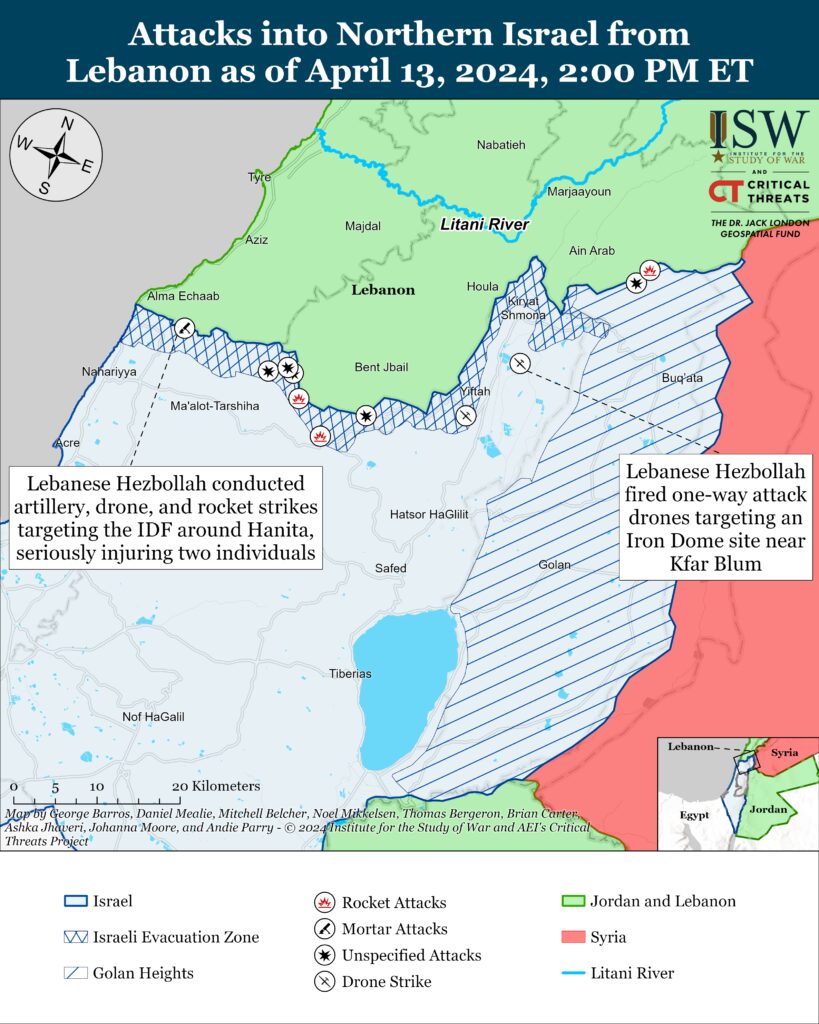
Recorded reports of attacks; CTP-ISW cannot independently verify impact.
 Eurasia Press & News
Eurasia Press & News
